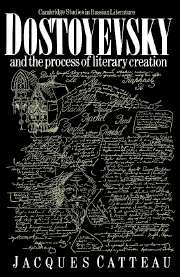Book contents
- Frontmatter
- Contents
- Preface to the English edition
- List of abbreviations
- General editor's note on transliteration and references
- General introduction
- PART I The creative environment
- PART II The process of creation
- Introduction
- 7 The writer at work
- 8 The great dialogue: the news item
- 9 The great dialogue: migrant images
- 10 The play of dialogue
- 11 The unity of thought in the novel
- 12 The summit of creative interrogation: ‘The Life of a Great Sinner’
- 13 A Raw Youth: reasons for choice
- 14 A Raw Youth: the appearance of the vision
- 15 A Raw Youth: the human architecture
- 16 A Raw Youth: the Idea of the novel
- 17 The composition of the novel in Dostoyevsky's work: choice of chronicle form
- 18 Composition of the novel in A Raw Youth: chronicle and stories
- Part III Time and space in the world of the novels
- Conclusion
- Notes
- Select bibliography
- Index of names
12 - The summit of creative interrogation: ‘The Life of a Great Sinner’
Published online by Cambridge University Press: 18 December 2009
- Frontmatter
- Contents
- Preface to the English edition
- List of abbreviations
- General editor's note on transliteration and references
- General introduction
- PART I The creative environment
- PART II The process of creation
- Introduction
- 7 The writer at work
- 8 The great dialogue: the news item
- 9 The great dialogue: migrant images
- 10 The play of dialogue
- 11 The unity of thought in the novel
- 12 The summit of creative interrogation: ‘The Life of a Great Sinner’
- 13 A Raw Youth: reasons for choice
- 14 A Raw Youth: the appearance of the vision
- 15 A Raw Youth: the human architecture
- 16 A Raw Youth: the Idea of the novel
- 17 The composition of the novel in Dostoyevsky's work: choice of chronicle form
- 18 Composition of the novel in A Raw Youth: chronicle and stories
- Part III Time and space in the world of the novels
- Conclusion
- Notes
- Select bibliography
- Index of names
Summary
The technique of a novel always sends us back to the metaphysics of the novelist.
Jean-Paul Sartre, Situations IThere was a typical interaction of these two creative lines in the period from the end of 1868 to December 1870. On the surface, Dostoyevsky was finishing The Idiot, of which the last five chapters appeared, late, in the February 1869 issue of The Russian Messenger; from September to December 1869 he was writing ‘The Eternal Husband’, a novella promised to Aurora where it was published in January and February 1870; he was then beginning The Devils, whose first chapters he sent to The Russian Messenger in October 1870. On the underground line, which is clearer in his correspondence than his notes, he seemed to be mainly occupied with two successive plans, thematically linked but profoundly different, ‘Atheism’ and ‘The Life of a Great Sinner’ which formed the great project of his entire life.
The reality is much more complex. The working notebooks of Dostoyevsky for this period, and even as early as 1867, contain, besides notes directly relating to The Idiot, ‘The Eternal Husband’ and The Devils, numerous other minor plans. They show that Dostoyevsky, even while he was composing, writing and dictating, was constantly tempted by different developments of themes and characters. This is not because he was incapable of maintaining the logic and unity of the narrative, or because he was distracted by the subjects which sprung up like weeds as he wrote, it was rather a matter of the creative dialectic between the novel which had to be finished and the same novel which remained essentially unfinished in its polyphonic mode.
- Type
- Chapter
- Information
- Dostoyevsky and the Process of Literary Creation , pp. 224 - 253Publisher: Cambridge University PressPrint publication year: 1989



